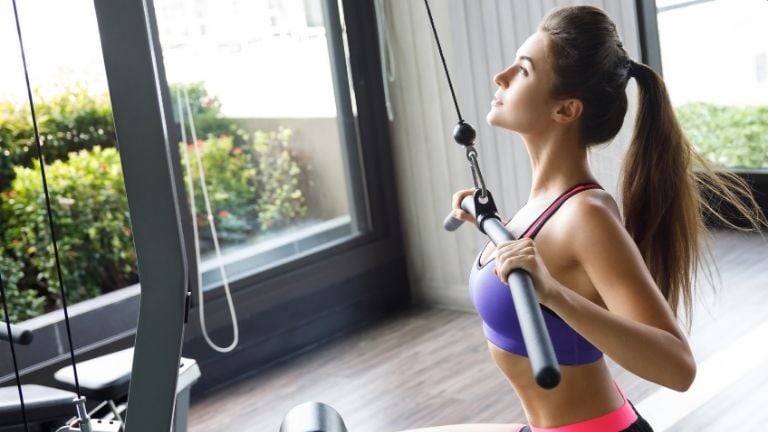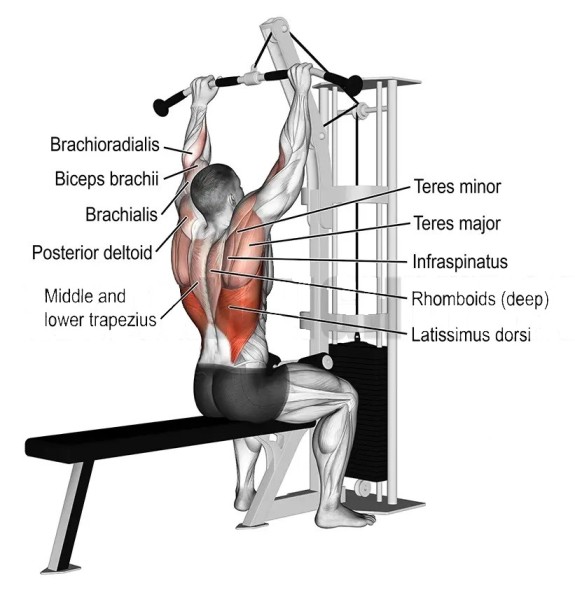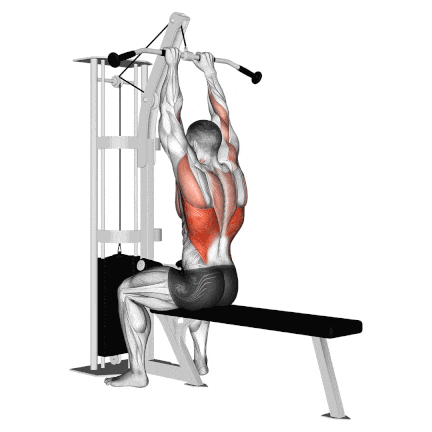Close Grip Lat Pulldown, also known as narrow grip lat pulldown, is a compound exercise that primarily targets the muscles in your back, specifically the latissimus dorsi. It differs from a regular lat pulldown where the grip is wider.
This variation is different from the standard lat pulldown, since you are using a wider grip.
By adopting a narrower grip on the pulldown bar—typically shoulder-width or slightly narrower—you shift the focus of the exercise.
This grip position allows for a shorter range of motion, which can intensify the contraction of your latissimus dorsi, particularly the lower and inner sections.
Want to take your gains to the next level? Discover your daily calorie needs with our free TDEE calculator

- Close Grip Lat Pulldown Muscles Worked
- How to Do Close Grip Lat Pulldown
- Narrow Grip Lat Pulldown Form And Technique
- Narrow Grip Lat Pulldown Variations
- 1. Underhand Close Grip Lat Pulldown
- 2. Single-Arm Lat Pulldown
- 3. Neutral-Grip Lat Pulldown
- FAQs
- What muscles does the close grip lat pulldown target?
- Can I modify this exercise for beginners?
Close Grip Lat Pulldown Muscles Worked
The Close Grip Lat Pulldown works many muscles. Parts of your body, like your back, arms, and shoulders, feel the burn.
- Primary Muscles: Latissimus dorsi
- Secondary Muscles: Biceps brachii, brachialis and brachioradialis, Rhomboids, Infraspinatus, Teres Minor, Teres Major and Trapezius (middle and lower)
- Stabilization Muscles: Core (transverse abdominis, obliques), Rotator Cuff Muscles, Erector spinae and Forearms

How to Do Close Grip Lat Pulldown
- Sit down on the lat pulldown machine and adjust the thigh pads so that your legs are comfortably secured under them. This will help prevent your body from lifting off the seat during the exercise.
- Attach the close-grip handle or V-bar to the high pulley.
- Grasp the handle with your palms facing each other or slightly inclined inward.
- Sit tall with your chest up and shoulders back. Look straight ahead. Your arms should be fully extended.
- Exhale and pull the handle down towards your upper chest. When you pull, focus on driving your elbows down and back, contracting the lats.
- At the bottom of the movement, pause briefly to maximize the muscle contraction in the lats.
- Slowly release the handle back to the starting position while inhaling.
- Perform the desired number of reps and sets.
Narrow Grip Lat Pulldown Form And Technique
Even though the close grip lat pulldown exercise is very popular, many people make common mistakes when they do it. Here are some of the things you should avoid:
- Avoid leaning back too much, as it can disengage the latissimus dorsi and strain your lower back unnecessarily. Maintain an upright posture, leaning slightly back, just enough to prevent the bar from hitting your face.
- Using body momentum to jerk the weight down makes the exercise less effective and increases the risk of injury. Instead, use a controlled, steady movement both while pulling the bar down and releasing it back up.
- Ensure you fully extend your arms at the starting position and pull the bar down at the upper chest level. Additionally, focus on squeezing the shoulder blades together at the bottom of the movement.
- Place your hands wider than shoulder-width apart on the bar with an overhand grip. Your wrists should be in a neutral position, aligned with your forearms.
- Avoid flaring the elbows too far out or dragging them too far back. This will reduce lat engagement and stress on the shoulders.

Narrow Grip Lat Pulldown Variations
Several variations of the close grip lat pulldown can add variety and challenge to your workout routine.
From single-arm lat pulldowns to reverse-grip and banded lat pulldowns, these variations target different muscles and increase the intensity of the exercise.
1. Underhand Close Grip Lat Pulldown
Also known as a supinated grip, your palms face towards you. This grip shifts the emphasis to lower lats, biceps, and middle traps compared to the overhand grip.
Some people find this grip to be more comfortable for their wrists and elbows.
2. Single-Arm Lat Pulldown
The single-arm lat pulldown is a variation of the traditional lat pulldown exercise. Instead of using both arms at once, you will use only one arm at a time. This exercise primarily targets the lats, but it also works your biceps and shoulders.
It is excellent for improving unilateral strength and addressing muscle imbalances between the sides of your body.
3. Neutral-Grip Lat Pulldown
The neutral-grip lat pulldown is a different way to exercise regular lat pulldown. It targets the muscles in your back, especially the latissimus dorsi or lats.
To perform this exercise, you sit down at a lat pulldown machine and grip the handles with your palms facing each other, creating a neutral grip.
Some benefits of performing the neutral-grip lat pulldown include improved back strength, increased core stability, and enhanced shoulder stability.
FAQs
What muscles does the close grip lat pulldown target?
The close grip lat pulldown primarily targets the latissimus dorsi muscles in your back and the biceps and forearms.
Can I modify this exercise for beginners?
Yes, beginners can start by using less weight or resistance on the machine and focusing on proper technique before gradually increasing intensity.
References
- Andersen, V., Fimland, M. S., Wiik, E., Skoglund, A., & Saeterbakken, A. H. (2014). Effects of grip width on muscle strength and activation in the lat pull-down. Journal of Strength and Conditioning Research, 28(4), 1135-1142. doi:10.1097/JSC.0000000000000232
- Lusk, S. J., Hale, B. D., & Russell, D. M. (2010). Grip width and forearm orientation effects on muscle activity during the lat pull-down. Journal of Strength and Conditioning Research, 24(7), 1895-1900.

Manish is a NASM-certified fitness and nutrition coach with over 10 years of experience in weight lifting and fat loss fitness coaching. He specializes in gym-based training and has a lot of knowledge about exercise, lifting technique, biomechanics, and more.
Through “Fit Life Regime,” he generously shares the insights he’s gained over a decade in the field. His goal is to equip others with the knowledge to start their own fitness journey.
